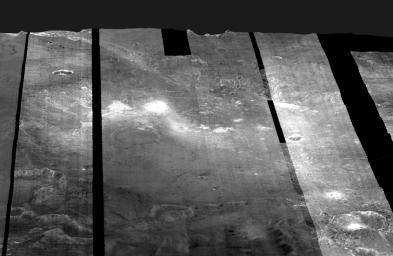
|
Gusev Crater
- Click the image above for a larger view
- Full-Res JPEG (2995 x 1953) (812.8 kB)
- Full-Res TIFF (2995 x 1953) (2.9 MB)
Caption:
This mosaic of nighttime infrared images of Gusev Crater, taken by the camera system on the Mars Odyssey spacecraft, has been draped over topography data obtained by Mars Global Surveyor. Variations in nighttime temperatures are due to differences in the abundance of rocky materials that retain their heat at night and stay relatively warm (bright). Fine grained dust and sand (dark) cools off more rapidly at night. This image mosaic covers an area approximately 180 kilometers (110 miles) on each side centered near 14 degrees S, 175 degrees E, looking toward the south in this simulated view.
Background Info:
NASA's Jet Propulsion Laboratory manages the 2001 Mars Odyssey mission for NASA's Office of Space Science, Washington, D.C. The thermal emission imaging system was provided by Arizona State University, Tempe. Lockheed Martin Astronautics, Denver, Colo., is the prime contractor for the project, and developed and built the orbiter. Mission operations are conducted jointly from Lockheed Martin and from JPL, a division of the California Institute of Technology in Pasadena.
Cataloging Keywords:
| Name | Value | Additional Values |
|---|---|---|
| Target | Mars | |
| System | ||
| Target Type | Planet | |
| Mission | 2001 Mars Odyssey | Mars Global Surveyor (MGS) |
| Instrument Host | Mars Odyssey | Mars Global Surveyor |
| Host Type | Orbiter | |
| Instrument | Thermal Emission Imaging System (THEMIS) | |
| Detector | ||
| Extra Keywords | Crater, Dust, Grayscale, Infrared, Thermal | |
| Acquisition Date | ||
| Release Date | 2003-03-13 | |
| Date in Caption | ||
| Image Credit | NASA/JPL/Arizona State University | |
| Source | photojournal.jpl.nasa.gov/catalog/PIA04261 | |
| Identifier | PIA04261 | |
